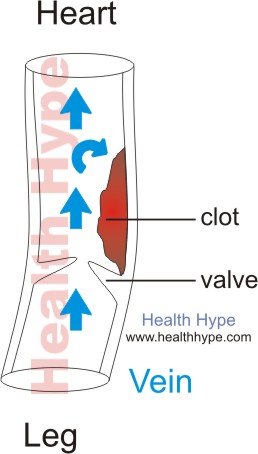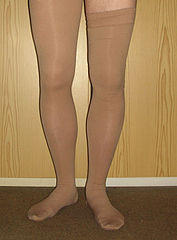How To Avoid Clots In The Leg Veins (DVT) When Traveling
The awareness about deep vein thrombosis (DVT) has created a lot of panic and confusion among travelers. It is often made out to be a silent condition that suddenly arises and can kill a traveler within minutes. However, this is not the typical case. In some instances, a person with DVT experienced almost no symptoms until it affected the blood vessels of the lungs – a life threatening condition known as pulmonary embolism. The majority of people with DVT do have symptoms as the condition worsens and there are early warning signs that should prompt the need for medical attention. But often these symptoms and warning signs are ignored. It is important to realize that DVT is preventable, treatable and even curable.
About Deep Vein Thrombosis

Deep vein thrombosis (DVT) in the simplest terms is a blood clot that forms in the lower leg or thigh veins that lie deeper in the limbs. Clotting is the body’s way of preventing blood loss when there is a break in a blood vessel. But a blood clot can sometimes form within an intact blood vessel be it an artery or vein. This is what happens in deep vein thrombosis. Due to several different factors, blood clots form and adhere to the wall of the vein. Initially it is small and does not cause a major problem. Sometimes there are episodes of mild symptoms at most. However, when this clot grows larger and obstruc0st the drainage of blood then symptoms become more prominent.
A larger clot in the leg veins has a greater chance of breaking away. If it does become dislodged, it can travel through the venous circulation, through the right side of the heart and can then block the main artery of the lung. It can cause damage to the lung and if large enough to severely obstruct blood flow, it can also affect oxygenation of blood. The latter can be deadly within minutes. This is known as pulmonary embolism and while it can occur for a number of reasons, it is most often associated with deep vein thrombosis (DVT). Intercepting the blood clot while it is still forming in the legs veins and commencing with appropriate treatment can prevent pulmonary embolism.
Prevent Deadly Leg Clots
The key to early and proper management is identifying the condition as soon as possible. While many people do not have symptoms, others often ignore milder symptoms of DVT. And in most instances, the symptoms of DVT are mild if non-existent. The second important factor in preventing deadly leg clots is to identify whether you are at high risk of developing DVT. By seeking medical advice, undergoing diagnostic investigations and commencing treatment even if there are no symptoms, a person can prevent serious complications.
Symptoms
- Swelling of the leg, which may sometimes only be visible on the foot and ankle.
- Leg pain including pain in the ankle or foot.
- Warmth of the skin over the site of the clot.
- Paleness of the skin on the leg, which may turn red or blue in color.
High Risk
- Occupations involving sitting and standing for long periods.
- Sudden episode of sitting for long periods like during flying or driving a long distance.
- Injury, infection or surgery to the leg.
- Pregnancy, even recent pregnancy.
- Recent prolonged bed rest like a hospital stay.
- Elderly people, particularly males, are at high risk.
- Cigarette smokers.
- Chronic blood clotting disorders.
- History of cancer, heart failure or inflammatory bowel disease.
Travel Tips
Even a person who is not considered to be at high risk and does not have symptoms of DVT can develop the condition with deadly consequences. Therefore it is important for every person to take preventative measures. It is not only older people who should practice these preventative measures. Even younger adults can benefit from it. Severe symptoms and pulmonary embolism in many instances occurs during or just after long trips. Here a person is stationary for long periods of time which increases the chances of larger clot formation and subsequent dislodging.
Some of these preventative measures includes :
- Exercising during a long trip.
- Increasing fluid intake.
- Avoiding diuretics like alcohol and caffeinated beverages.
- Wearing elastic compression stockings.
- Using medication that will prevent blood clot formation.
Exercise Every Half Hour
Movement of blood through the leg veins is dependent on the leg and foot muscles contracting and relaxing. When there is no movement, the blood stays relatively stationary. This is known as venous stasis. It is one of the triggers for blood clot formation. While it can occur in any part of the body, it is usually worse in the leg veins since the blood has the additional impedance of gravity. Exercising at least every 30 minutes during a long trip can reduce the chances of clotting. You should wake up and walk around but there are even leg exercises that you can do in your seat. Read more on how to improve leg circulation.
Drink Water and Avoid Alcohol

An increase in the viscosity (thickness) of the blood can also increase the chance of blood clot formation. This may occur when you have too many red blood cells or if the fluid content in your blood is lower than normal. The latter is more likely to occur with dehydration. Drinking insufficient water is one way this happens. Another is through the use of diuretics – substances that causes water loss from the body. Alcoholic and caffeinated beverages are two widely used diuretics, especially on long flights. Therefore it is important to drink plenty of water and abstain from alcohol and coffee to reduce the chance of DVT.
Do Not Take Sleeping Tablets
If you are using sleeping tablets to overcome the anxiety and monotony of a long flight, then you may be increasing your risk of DVT. By sedating yourself, you will be stationary during the duration of your trip, or at least for most of it. Less movement means a greater chance of blood clot formation. It also means that you cannot wake up to walk around or do leg exercises which are important ways to prevent DVT during travel. Sleeping tablets can also slow down your heart rate which in turn slows down the flow of blood throughout the body, including the legs. Pain tablets and allergy medicine may also have a similar effect and should be used in moderation during a long flight or drive.
Use Compression Stockings

Elastic compression stockings may also be helpful. It provides firm pressure on the leg and in turn on the veins and assists with the blood flow back to the heart. Elastic compression stockings are most useful when used continuously over weeks and months. But it can be helpful to some degree for short periods like when traveling. Always speak to your doctor about using elastic compression stockings. There are different types of stockings with varying degrees of compressions. Your doctor and pharmacist will advise you on the best option for your trip or for long term use. Remember that a compression stocking does not mean that you can avoid the other measures to prevent DVT.
Take Anticoagulant Medication
There are various drugs that can prevent the blood from clotting. These anti-clotting drugs are known as anticoagulants. It is important to speak to your doctor about anticoagulants. You may need to be using these drugs for the long term. Some common anticoagulants like aspirin are not as useful in preventing blood clots in the veins and may not be as helpful in DVT prevention. Instead your doctor will prescribe other anticoagulant drugs like heparin. These drugs should be used exactly as prescribed and should not be shared with friends or family members who may be traveling with you. Do not change the dose prior to a trip unless your doctor approves it.
References:
www.patient.co.uk/health/deep-vein-thrombosis-prevention-when-travelling.htm
www.mayoclinic.com/health/deep-vein-thrombosis/DS01005/DSECTION=prevention





